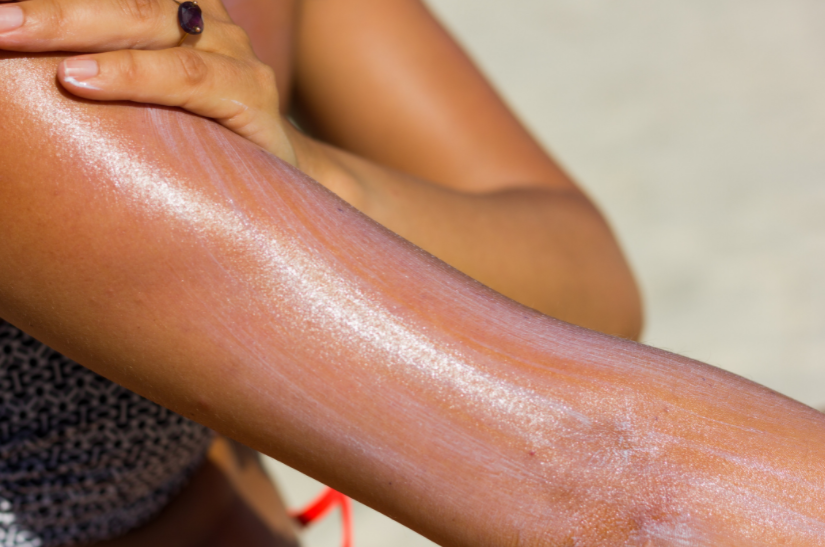Sun: The good and the not-so-good
Sunlight is essential for many important bodily functions, including producing vitamin D and maintaining your circadian rhythm and mood. Yet too much sun exposure can also be harmful. Ultraviolet (UV) radiation may result in short-term and long-term skin damage, including sunburn, signs of aging, and even skin cancer.
Approximately 95% of the UV radiation reaching our skin is ultraviolet A (UVA) light, which is primarily responsible for chronic effects such as photoaging, wrinkling, and age spots. Ultraviolet B (UVB) rays make up a smaller percentage but may be potentially even more harmful, as they are the primary cause of sunburns. Both UVA and UVB may cause skin cancer.
Even with all of these risks, many people still head to the beach with nothing more than their bathing suits, hoping to get tan. For some, a lobster-red burn is considered a badge of a successful beach day. This is absolutely not recommended. Any prolonged UV light exposure can put you at risk even if it isn’t summer, such as if you are out skiing in the winter with the sun reflected from the snow, or if you are indoors but using a tanning bed. So what can you do to protect yourself from these harmful rays?
There are many types of sunscreens available. Sunscreens work because they contain filters that reflect, scatter, or absorb UV radiation that otherwise would reach your skin. There are two main types of sunscreens available, separated into “organic filters” (aka chemical sunscreens) and “inorganic filters” (aka physical sunscreens).
Sun protection with chemical sunscreens (organic filters)
Organic filters absorb UV radiation and convert it into a small amount of heat. In the ingredients listed on the bottle, you may notice compounds such as oxybenzone, avobenzone, and octocrylene. Oxybenzone and avobenzone are relatively good filters for UVA radiation; however, they may be paired with other agents such as octocrylene, homosalate, and octisalate to stabilize them and provide UVB protection. In other countries, newer compounds including Tinosorb M/S, Mexoryl SX, and Mexoryl XL have been developed that are now being used as broad-spectrum sunscreens.
Sun protection with physical sunscreens (inorganic filters)
Inorganic filters are mineral compounds such as zinc oxide and titanium dioxide that theoretically work by reflecting and scattering UV light to protect your skin. However, some studies have shown that these compounds actually work by absorbing UV radiation and converting it into heat. These sunscreens tend to offer more broad-spectrum protection against both UVA and UVB light. They also tend to be the formulations used in children’s sunscreens, as they are easier on sensitive skin. These sunscreens tend to go on thicker and may appear whiter.
Use it correctly for effective sun protection
We recommend that everyone use sunscreen with sun protection factor (SPF) of 30 or higher when you spend time outdoors. SPF 30 will protect against approximately 97% of UVB rays. Sunscreens with SPF greater than 50 provide only a very small increase in protection against UV radiation.
Everyone, regardless of skin colour, should wear sunscreen, because we are all at risk of the adverse effects of UV radiation and can benefit from protection. However, it is even more important for those with lighter skin shades who are more susceptible to these effects to wear sunscreen. The American Academy of Paediatrics recommends avoiding the use of sunscreen in children younger than six months, and instead emphasizes minimal sun exposure and to ensure adequate clothing and shade.
We recommend applying sunscreen using the “teaspoon and shot glass rule”: 1 teaspoon of sunscreen to the face and neck, and enough to fit a shot glass (approximately 30ml) for exposed areas of your body. You should apply sunscreen 15 to 30 minutes before sun exposure, then wait for 10 to 20 minutes before getting dressed. We recommend re-application of sunscreen at least every two hours, or after every water exposure or sweating even if they are labelled water-resistant.
In addition to wearing sunscreen, always wear appropriate protective clothing such as wide-brimmed hats, long-sleeved clothing, and pants when possible. Seek shade, wear sunglasses to protect your eyes, and avoid tanning beds. Remember to stay hydrated, and sunscreen up!
And what if you do get a sunburn?
If you get a sunburn, it is important to treat it right away. Seek shade and avoid being in the sun for any prolonged time.
One of the most important things in sunburn care is to drink extra water. When you have a sunburn, you actually lose more water from your body because the sunburn draws fluid to the skin surface, and the extra heat leads to increased evaporation. Topical therapies that may help with your symptoms include cool baths, gentle moisturizers, and even over-the-counter hydrocortisone cream, which may help ease the discomfort. If you have significant discomfort, you can also take aspirin or ibuprofen as directed. As always, if you ever have concerns, talk to your doctor.

